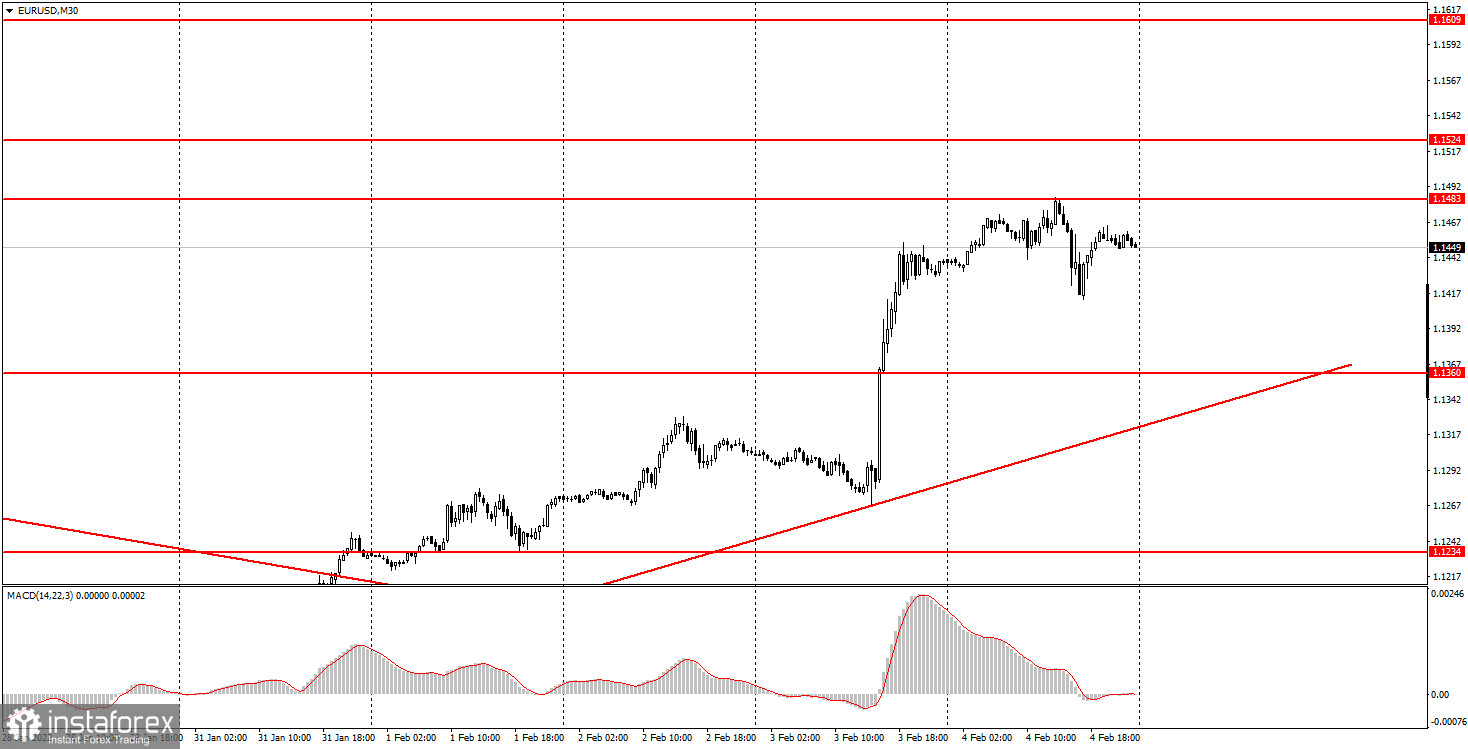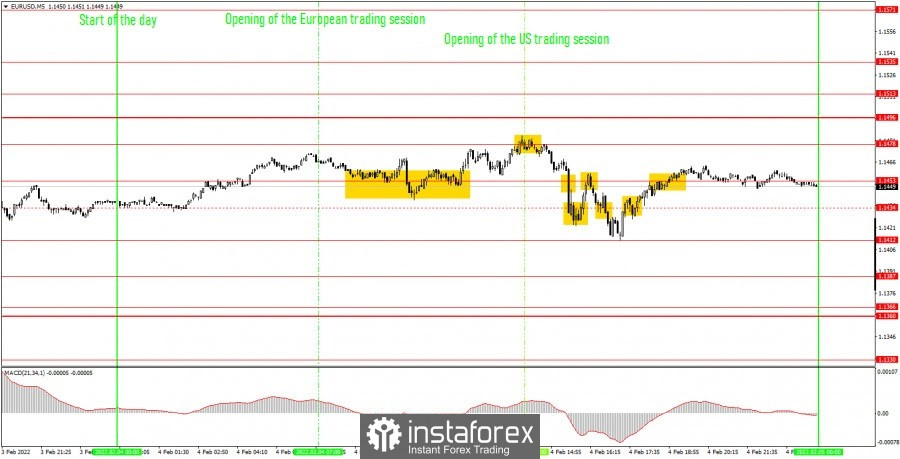Analysis of previous deals:
30M chart of the EUR/USD pair

The EUR/USD pair continued to trade with rather high volatility on Friday. Although, of course, not the same as the days before. Recall that last week the euro rose by 300 points, which absolutely does not correspond to the nature of the fundamental background. Recall that the European Central Bank did not raise the key rate and did not even hint that such a decision could be made in 2022. Therefore, it is a mystery why the euro currency rose by 150 points on Thursday. On Friday, the pair's movement was again not the most logical. On the one hand, a correction is quite expected after so much strong growth this week. The pair declined after a strong Nonfarm report was released in America, which shows the number of new jobs created outside the agricultural sector. This is one of the strongest reports on the foreign exchange market. However, at the same time, the dollar's growth after the publication of such an important report was rather weak. Only 30-40 points. Thus, we believe that the euro currency has grown completely unreasonably. But at the same time, it can be a strong signal to start a new long-term trend.
5M chart of the EUR/USD pair

The movement on the 5-minute timeframe on Friday looks quite strange. The pair moved mainly sideways in the European trading session, and down in the US one, but with pullbacks and corrections. That is, trading on Friday was very difficult, especially for novice traders. Nevertheless, let's analyze the trading signals. At first, the pair formed a signal near the level of 1.1453 for several hours. The rebound from it provoked an increase to the level of 1.1478, from which the price also rebounded. Therefore, newcomers could earn about 10 points of profit here. The rebound from 1.1478 could be used to open short positions, however, an hour after the formation of this signal, strong statistics in the United States should have been released. Therefore, it was necessary either to set a Stop Loss and count on a strong NonFarm Payrolls report here, or to leave the market so as not to take risks. In principle, any option was acceptable. The pair did not even begin to fall after the Nonfarm was published, but began to "jump" up and down and eventually ended the day approximately where it was before the release of Nonfarm. Thus, there was no special effect from the publication of these statistics. Naturally, all signals after the publication of the report should have been ignored.
How to trade on Monday:
The upward trend continues on the 30-minute timeframe. However, the price is located quite far from the trend line, so the pair may strive for it during the current week. Moreover, after such a strong growth, a correction is necessary. There are few prerequisites for the euro's succeeding growth, but there were few of them last week... On the 5-minute TF, it is recommended to trade by levels 1.1387, 1.1412, 1.1453, 1.1478, 1.1496, 1.1513, 1.1535. Neither the European Union nor the United States will publish a single important report or other important event on Monday. Therefore, tomorrow the day will be absolutely empty, volatility may fall, and the pair may tend to fall, as a downward correction is needed, and the markets may continue to work out the NonFarm Payrolls report, which implies an increase in the dollar.
Basic rules of the trading system:
1) The signal strength is calculated by the time it took to form the signal (bounce or overcome the level). The less time it took, the stronger the signal.
2) If two or more deals were opened near a certain level based on false signals (which did not trigger Take Profit or the nearest target level), then all subsequent signals from this level should be ignored.
3) In a flat, any pair can form a lot of false signals or not form them at all. But in any case, at the first signs of a flat, it is better to stop trading.
4) Trade deals are opened in the time period between the beginning of the European session and until the middle of the American one, when all deals must be closed manually.
5) On the 30-minute TF, using signals from the MACD indicator, you can trade only if there is good volatility and a trend, which is confirmed by a trend line or a trend channel.
6) If two levels are located too close to each other (from 5 to 15 points), then they should be considered as an area of support or resistance.
On the chart:
Support and Resistance Levels are the Levels that serve as targets when buying or selling the pair. You can place Take Profit near these levels.
Red lines are the channels or trend lines that display the current trend and show in which direction it is better to trade now.
The MACD indicator (14,22,3) consists of a histogram and a signal line. When they cross, this is a signal to enter the market. It is recommended to use this indicator in combination with trend lines (channels and trend lines).
Important speeches and reports (always contained in the news calendar) can greatly influence the movement of a currency pair. Therefore, during their exit, it is recommended to trade as carefully as possible or exit the market in order to avoid a sharp price reversal against the previous movement.
Beginners on Forex should remember that not every single trade has to be profitable. The development of a clear strategy and money management are the key to success in trading over a long period of time.
 English
English 
 Русский
Русский Bahasa Indonesia
Bahasa Indonesia Bahasa Malay
Bahasa Malay ไทย
ไทย Español
Español Deutsch
Deutsch Български
Български Français
Français Tiếng Việt
Tiếng Việt 中文
中文 বাংলা
বাংলা हिन्दी
हिन्दी Čeština
Čeština Українська
Українська Română
Română

